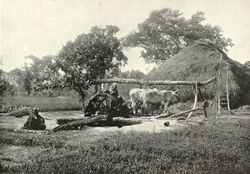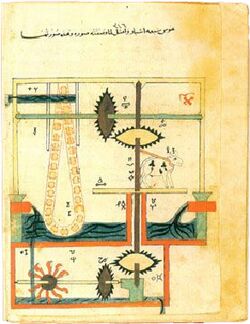Sakia
Topic: Engineering
 From HandWiki - Reading time: 7 min
From HandWiki - Reading time: 7 min
A saqia, alternative spelling sakieh, saqia or saqiya (from Arabic: ساقية, sāqiyah), also called Persian wheel, tablia, rehat, and in Latin tympanum[1] is a mechanical water lifting device, similar in function to a scoop wheel, which uses buckets, jars, or scoops fastened either directly to a vertical wheel, or to an endless belt activated by such a wheel. The vertical wheel is itself attached by a drive shaft to a horizontal wheel, which is traditionally set in motion by animal power (oxen, donkeys, etc.) Because it is not using the power of flowing water, the sakia is different from a noria and any other type of water-wheel. It is still used in India , Egypt and other parts of the Middle East, and in the Iberian Peninsula and the Balearic Islands. It may have been invented in Hellenistic Egypt, Persia or India . The sakia was mainly used for irrigation, but not exclusively, as the example of Qusayr Amra shows, where it was used at least in part to provide water for a royal bathhouse.[2]
Description; performance
With buckets directly on the wheel
The sakia is a large hollow wheel, traditionally made of wood. One type has its clay pots or buckets attached directly to the periphery of the wheel, which limits the depth it can scoop water from to less than half its diameter. The modern version is normally made of galvanized sheet steel and consists of a series of scoops. The modern type dispenses the water near the hub rather than from the top, the opposite of the traditional types. It is a method of irrigation frequently met within various parts of the Indian subcontinent.
Sakia wheels range in diameter from two to five metres. Though traditionally driven by draught animals, they are now increasingly attached to an engine. While animal-driven sakias can rotate at 2–4 rpm, motorised ones can make as much as 8–15 rpm. The improved modern versions are also known as zawaffa and jhallan.
With buckets attached to endless belt
The historical Middle-Eastern device known in Arabic as saqiya usually had its buckets attached to a double chain, creating a so-called "pot garland". This allowed scooping water out of a much deeper well.
An animal-driven sakia can raise water from 10–20 metres depth, and is thus considerably more efficient than a swape or shadoof, as it is known in Arabic, which can only pump water from 3 metres.
"Sakia"/"saqiya" versus "noria"
The terms referring to traditional as well as modern water-raising devices used in the Middle East, India , Spain and other areas are sometimes used rather loosely. One clear distinction though is important. The term noria is commonly used for devices using the power of moving water. For devices powered by animals, the usual term is sakia or saqiya. The term "water-wheel" is reserved, by definition, to wheels powered by flowing water, and should not be used for sakia wheels which are only lifting the water, but are not powered by it. Other types of similar devices are grouped under the name of chain pumps. In Spain the term noria is used also for some devices which are actually sakias.
A sakia or saqiya differs from a noria in two substantial ways. First, by the way it is powered, namely by animal power or rarely by wind, in modern versions also by engines, but never by hydropower. The other difference is that a saqiya is lifting the water out of a well or a body of standing water, while the noria is placed on the bank of a river.
A noria in contrast uses the water power obtained from the flow of a river. The noria consists of a large, very narrow undershot water-wheel, whose rim is made up of a series of containers which lift water from the river to a very small aqueduct at the top of the wheel. In this it is very similar to the one type of sakia without a pot-garland, with the posts mounted directly on the wheel, thus the widespread confusion.
A few historic norias were hybrids, consisting of waterwheels assisted secondarily by animal power.
In Spanish an animal-driven sakia is named aceña, with the exception of the Cartagena area, where it is called a noria de sangre, or "waterwheel of blood". Another, much rarer type of sakia uses the same system, of a necklace of clay or wooden buckets, but it is driven by the wind. The wind-driven sakias in the vicinity of Cartagena are virtually identical in appearance with the local grinding mills.
Types
There are two main types of sakia. One type consist of a vertical wheel which is slung with an endless belt or chain of buckets. The buckets hang down into a well which may be up to 8 m (26 ft) deep.
The second type has the buckets or other water containers attached directly to the vertical wheel.
The most primitive sakias are driven by donkeys, mules, or oxen. The animal turns a horizontal wheel, which is engaged with the vertical wheel and so causes it to turn. This causes the buckets of the first type to circulate and lift up water from a deeper well, or with the second type, it causes the vertical wheel to rotate and scoop up water from a less deep well.
In terms of propulsion, there is a different, much rarer type of sakia which uses the same general technique, but it is driven by wind. The wind-driven sakias in the vicinity of Cartagena, Spain, are virtually identical in appearance with the local grinding mills.
History
India
The sakia might, according to Ananda Coomaraswamy, have been invented in India, where the earliest reference to it is found in the Panchatantra (c. 3rd century BCE), where it was known as an araghaṭṭa;[3] which is a combination or the words ara (speedy or a spoked[wheel]) and ghaṭṭa "pot"[4] in Sanskrit. That device was either used like a sakia, to lift water from a well while being powered by oxen or people, or it was used to irrigate fields when it was powered in the manner of a water-wheel by being placed in a stream or large irrigation channel. In the latter case we usually speak of a "noria" as opposed to a "sakia".[5] Before panchatantras there is reference of water wheel in Rugved,10th mandal 101/7
Egypt
Paddle-driven water-lifting wheels had appeared in ancient Egypt by the 4th century BCE.[6] According to John Peter Oleson, both the compartmented wheel and the hydraulic noria appeared in Egypt by the 4th century BCE, with the sakia being invented there a century later. This is supported by archeological finds at Faiyum, where the oldest archeological evidence of a water wheel has been found, in the form of a sakia dating back to the 3rd century BCE. A papyrus dating to the 2nd century BCE also found in Faiyum mentions a water wheel used for irrigation, a 2nd-century BC fresco found at Alexandria depicts a compartmented sakia, and the writings of Callixenus of Rhodes mention the use of a sakia in the Ptolemaic Kingdom during the reign of Ptolemy IV Philopator in the late 3rd century BCE.[7]
Early Mediterranean evidence of a sakia is from a tomb painting in Ptolemaic Egypt that dates to the 2nd century BCE. It shows a pair of yoked oxen driving a compartmented waterwheel. The sakia gear system is already shown fully developed to the point that "modern Egyptian devices are virtually identical".[8] It is assumed that the scientists of the Musaeum, at the time the most active Greek research center, may have been involved in its implementation.[9] An episode from Caesar's Civil War in 48 BC tells of how Caesar's enemies employed geared waterwheels to pour sea water from elevated places on the position of the trapped Romans.[10]
Talmudic sources
The term used by Talmudic sources for a sakia is 'antelayyā-wheel.[11]
Medieval Islamic realm
A manuscript by Ismail al-Jazari featured an intricate device based on a saqiya, powered in part by the pull of an ox walking on the roof of an upper-level reservoir, but also by water falling onto the spoon-shaped pallets of a water wheel placed in a lower-level reservoir.[12]
Complex saqiyas consisting of more than 200 separate components were used extensively by Muslim inventors and engineers in the medieval Islamic world.[13] The mechanical flywheel, used to smooth out the delivery of power from a driving device to a driven machine and, essentially, to allow lifting water from far greater depths (up to 200 metres), was first employed by ibn Bassal (fl. 1038–1075), of al-Andalus.[14][15]
The first known use of a crankshaft in a saqiya was featured in another one of al-Jazari's machines.[16][verification needed] The concept of minimising the intermittence is also first implied in one of al-Jazari's saqiya devices, which was to maximise the efficiency of the saqiya.[16] Al-Jazari also constructed a water-raising device that was run by hydropower, though the Chinese had been using hydropower for the same purpose before him. Animal-powered saqiyas and water-powered norias similar to the ones he described have been supplying water in Damascus since the 13th century,[17] and were in everyday use throughout the medieval Islamic world.[16]
See also
Notes
- ↑ "Water lifting devices". http://www.fao.org/docrep/010/ah810e/AH810E05.htm#5.4.2. Retrieved 28 May 2016.
- ↑ "Qusayr 'Amra : Site Management Plan" (PDF). January 2014. https://whc.unesco.org/document/127108. Retrieved 2016-05-28.
- ↑ "The Persian Wheel in India". Base.d-p-h.info. http://base.d-p-h.info/en/fiches/dph/fiche-dph-7866.html. Retrieved 2016-05-28.
- ↑ Klaus Glashoff. "Sanskrit Dictionary for Spoken Sanskrit". Spokensanskrit.de. http://spokensanskrit.de/index.php?script=HK&beginning=0+&tinput=+ara&trans=Translate&direction=AU. Retrieved 2016-05-28.
- ↑ "The Persian Wheel revisited- Araghatta | Harvesting Rainwater". Rainwaterharvesting.wordpress.com. https://rainwaterharvesting.wordpress.com/2008/02/23/the-persian-wheel-revisited-araghatta/. Retrieved 2016-05-28.
- ↑ Örjan Wikander (2008). "Chapter 6: Sources of Energy and Exploitation of Power". in John Peter Oleson. The Oxford Handbook of Engineering and Technology in the Classical World. Oxford University Press. pp. 141–2. ISBN 0-19-518731-8.
- ↑ Adriana de Miranda (2007). Water architecture in the lands of Syria: the water-wheels. L'Erma di Bretschneider. pp. 38–9. ISBN 88-8265-433-8.
- ↑ Oleson 2000, pp. 234, 270
- ↑ Oleson 2000, pp. 271f.
- ↑ Oleson 2000, p. 271
- ↑ Robert R. Stieglitz (2006). "Tel Tanninim". The Bible and Interpretation. http://www.bibleinterp.com/excavations/Tanninim_032901.shtml. Retrieved 16 September 2015.
- ↑ Needham, Volume 4, Part 2, p. 353.
- ↑ Donald Hill (1996), "Engineering", in Roshdi Rashed, Encyclopedia of the History of Arabic Science, Vol. 3, pp. 751–795 [771].
- ↑ "Flywheel". http://themechanic.weebly.com/uploads/4/3/5/7/4357357/flywheel.pdf.
- ↑ Shabbir, Asad. "The Role of Muslim Mechanical Engineers In Modern Mechanical Engineering Dedicate to12th Century Muslim Mechanical Engineer". https://www.irfi.org/general/Microsoft%20Word%20-%20T_h_e_role_of_Muslim_Mechanical_Engineers_In_Modern_Mechanical_Engineering.pdf.
- ↑ 16.0 16.1 16.2 Donald Hill, "Engineering", p. 776, in Roshdi Rashed, ed., Encyclopedia of the History of Arabic Science, Vol. 2, pp. 751–795, Routledge, London and New York
- ↑ "Archived copy". http://www.history-science-technology.com/Articles/articles%206.htm.
References
- Oleson, John Peter (2000), "Water-Lifting", in Wikander, Örjan, Handbook of Ancient Water Technology, Technology and Change in History, 2, Leiden: Brill, pp. 217–302, ISBN 90-04-11123-9
Further reading
- Fraenkel, P., (1990) "Water-Pumping Devices: A Handbook for users and choosers" Intermediate Technology Publications.
- Molenaar, A., (1956) "Water lifting devices for irrigation" FAO Agricultural Development Paper No. 60, Food and Agriculture Organization of the United Nations, Rome.
External links
- Description at the Sakia.org website.
 KSF
KSF


